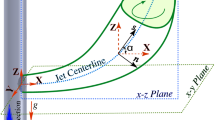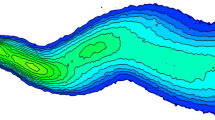Abstract
Simultaneous measurements of velocity and concentration using stereoscopic particle image velocimetry (stereo-PIV) and planar laser-induced fluorescence (PLIF) were used to investigate the mixing performance of a scaled-up multi-inlet vortex reactor (MIVR). Data were collected in three measurement planes located at different heights from the reactor bottom (¼, ½, and ¾ of the reactor height) for Reynolds numbers of 3250 and 8125 based on the reactor inlet velocity and hydraulic diameter. The collected data were analyzed to determine turbulent flow statistics such as turbulent viscosity, turbulent diffusivity, and turbulent Schmidt number. When analyzed across 16 different azimuth angles and radial positions (r) normalized by the reactor radius (Ro), the turbulent viscosity was found to be nearly axisymmetric. In the free-vortex region (r/Ro > 0.2), the turbulent viscosity results were nearly constant. Near the center of the reactor in the forced-vortex region (r/Ro < 0.1), the turbulent viscosity significantly increased, with peak values occurring near the center. The turbulent viscosity and Reynolds shear stress were highest near the reactor exit at the ¾ plane. The dominance of high turbulent fluxes and low concentration gradients near the reactor center led to high turbulent diffusivity. Away from the center, the turbulent diffusivity was reduced because of large concentration gradients and low turbulence intensity in the spiral arm region. The turbulent Schmidt numbers were also found to correlate with concentration gradients. The turbulent Schmidt number values were found to vary from 0.1 to 1.2. The highest spatial variation in \(S{c_t}\) was observed in the spiral arms region, where the concentration gradients are also the highest. This spatial variation in Schmidt number contrasts with the common assumption of constant \(S{c_t}\) in Reynolds-averaged CFD models.
Graphical abstract
A typical stereo-PIV/PLIF simultaneous instantaneous measurement for Re = 8125. The color and vectors represent the instantaneous mixture fraction and in-plane velocity field, respectively. (a) ¼ Plane. (b) ½ Plane. (c) ¾ Plane.













Similar content being viewed by others
References
Altuglass International-Arkema Inc. (2006) Plexiglass general information and physical properties. http://www.plexiglas.com/export/sites/plexiglas/.content/medias/downloads/sheet-docs/plexiglas-general-information-and-physical-properties.pdf. Accessed 10 Oct 2017
Bensaid S, Deorsola FA, Marchisio DL, Russo N, Fino D (2014) Flow field simulation and mixing efficiency assessment of the multi-inlet vortex mixer for molybdenum sulfide nanoparticle precipitation. Chem Eng J 238:66–77
Bohl D, Foss J (1996) Enhancement of passive mixing tabs by the addition of secondary tabs. In: 34th aerospace sciences meeting and exhibit, p 545
Cheng JC, Olsen MG, Fox RO (2009) A microscale multi-inlet vortex nanoprecipitation reactor: Turbulence measurement and simulation. Appl Phys Lett 94(20):204104
Chua LP, Yu SCM, Wang XK (2003) Flow visualization and measurements of a square jet with mixing tabs. Exp Thermal Fluid Sci 27(6):731–744
Crimaldi JP, Koseff JR (2001) High-resolution measurements of the spatial and temporal scalar structure of a turbulent plume. Exp Fluids 31(1):90–102
D’addio SM, Prud’homme RK (2011) Controlling drug nanoparticle formation by rapid precipitation. Adv Drug Deliv Rev 63(6):417–426
Feng H, Olsen MG, Liu Y, Fox RO, Hill JC (2005) Investigation of turbulent mixing in a confined planar-jet reactor. AIChE J 51(10):2649–2664
Feng H, Olsen MG, Hill JC, Fox RO (2007) Simultaneous velocity and concentration field measurements of passive-scalar mixing in a confined rectangular jet. Exp Fluids 42(6):847–862
Feng H, Olsen MG, Hill JC, Fox RO (2010) Investigation of passive scalar mixing in a confined rectangular wake using simultaneous PIV and PLIF. Chem Eng Sci 65(11):3372–3383
Filatyev SA, Thariyan MP, Lucht RP, Gore JP (2007) Simultaneous stereo particle image velocimetry and double-pulsed planar laser-induced fluorescence of turbulent premixed flames. Combust Flame 150(3):201–209
Finnie GJ, Kruyt NP, Ye M, Zeilstra C, Kuipers JAM (2005) Longitudinal and transverse mixing in rotary kilns: A discrete element method approach. Chem Eng Sci 60(15):4083–4091
Flesch TK, Prueger JH, Hatfield JL (2002) Turbulent Schmidt number from a tracer experiment. Agric For Meteorol 111(4):299–307
Gaydon M, Raffel M, Willert C, Rosengarten M, Kompenhans J (1997) Hybrid stereoscopic particle image velocimetry. Exp Fluids 23(4):331–334
Graftieaux L, Michard M, Grosjean N, Combining PIV (2001) POD and vortex identification algorithms for the study of unsteady turbulent swirling flows. Meas Sci Technol 12:1422–1429
Gretta WJ, Smith CR (1993) The flow structure and statistics of a passive mixing tab. J Fluids Eng 115(2):255–263
Guillard F, Fritzon R, Revstedt J, Trägårdh C, Alden M, Fuchs L (1998) Mixing in a confined turbulent impinging jet using planar laser-induced fluorescence. Exp Fluids 25(2):143–150
Han J, Zhu Z, Qian H, Wohl AR, Beaman CJ, Hoye TR, Macosko CW (2012) A simple confined impingement jets mixer for flash nanoprecipitation. J Pharm Sci 101(10):4018–4023
He G, Guo Y, Hsu AT (1999) The effect of Schmidt number on turbulent scalar mixing in a jet-in-crossflow. Int J Heat Mass Transf 42(20):3727–3738
Johnson BK, Prud’homme RK (2003) Flash nanoprecipitation of organic actives and block copolymers using a confined impinging jets mixer. Aust J Chem 56(10):1021–1024
Kong B, Olsen MG, Fox RO, Hill JC (2011) Population, characteristics and kinematics of vortices in a confined rectangular jet with a co-flow. Exp Fluids 50(6):1473–1493
Larsson IS, Johansson SP, Lundström TS, Marjavaara BD (2015) PIV/PLIF experiments of jet mixing in a model of a rotary kiln. Exp Fluids 56(5):111
Liu Y, Cheng C, Prud’homme RK, Fox RO (2008) Mixing in a multi-inlet vortex mixer (MIVM) for flash nano-precipitation. Chem Eng Sci 63(11):2829–2842
Liu Z, Ramezani M, Fox RO, Hill JC, Olsen MG (2015) Flow characteristics in a scaled-up multi-inlet vortex nanoprecipitation reactor. Ind Eng Chem Res 54(16):4512–4525
Liu Z, Hitimana E, Olsen MG, Hill JC, Fox RO (2017) Turbulent mixing in the confined swirling flow of a multi-inlet vortex reactor. AIChE J 63(6):2409–2419
Saad WS, Prud’homme RK (2016) Principles of nanoparticle formation by flash nanoprecipitation. Nano Today 11(2):212–227
Shi Y, Fox RO, Olsen MG (2011) Confocal imaging of laminar and turbulent mixing in a microscale multi-inlet vortex nanoprecipitation reactor. Appl Phys Lett 99(20):204103
Shi Y, Cheng JC, Fox RO, Olsen MG (2013) Measurements of turbulence in a microscale multi-inlet vortex nanoprecipitation reactor. J Micromech Microeng 23(7):075005
Smith SH, Mungal MG (1998) Mixing, structure and scaling of the jet in crossflow. J Fluid Mech 357:83–122
Tominaga Y, Stathopoulos T (2007) Turbulent Schmidt numbers for CFD analysis with various types of flowfield. Atmos Environ 41(37):8091–8099
Wegner B, Huai Y, Sadiki A (2004) Comparative study of turbulent mixing in jet in cross-flow configurations using LES. Int J Heat Fluid Flow 25(5):767–775
Yeung PK, Xu S, Sreenivasan KR (2002) Schmidt number effects on turbulent transport with uniform mean scalar gradient. Phys Fluids 14(12):4178–4191
Yimer I, Campbell I, Jiang LY (2002) Estimation of the turbulent Schmidt number from experimental profiles of axial velocity and concentration for high-Reynolds-number jet flows. Can Aeronaut Space J 48(3):195–200
Author information
Authors and Affiliations
Corresponding author
Additional information
Publisher’s Note
Springer Nature remains neutral with regard to jurisdictional claims in published maps and institutional affiliations.
Rights and permissions
About this article
Cite this article
Hitimana, E., Fox, R.O., Hill, J.C. et al. Experimental characterization of turbulent mixing performance using simultaneous stereoscopic particle image velocimetry and planar laser-induced fluorescence. Exp Fluids 60, 28 (2019). https://doi.org/10.1007/s00348-018-2669-y
Received:
Revised:
Accepted:
Published:
DOI: https://doi.org/10.1007/s00348-018-2669-y




